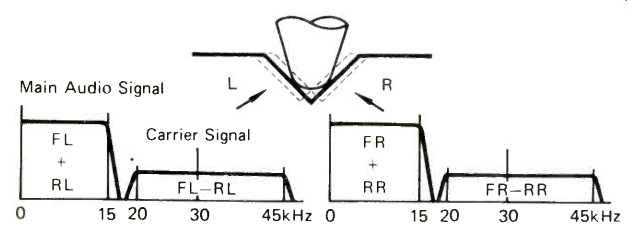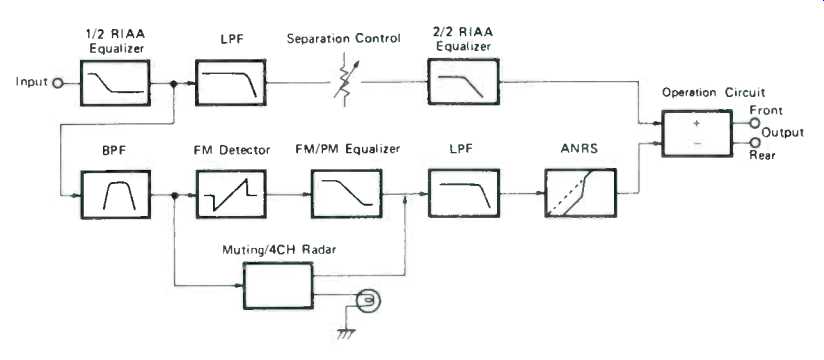By George W. Tillett
JVC and RCA have made considerable progress with their "discrete" disc during the past year or so. The first releases had a reduced playing time, lower output and dynamic range, and quite high distortion. There were problems associated with the 30 kHz carrier and the phono cartridge-plus a high noise level. But now, all-or most-of these difficulties have been overcome with improved circuitry, new record materials, and better cutter heads.
Not forgetting that Shibata stylus! Recent CD-4 issues are comparable with two-channel or matrix discs, but before we take a quick look at some of them, it will be appropriate if we describe the basics of the CD-4 system.
(Readers who are familiar with the principles can skip this section.) Figure 1 shows the signal arrangement in a CD-4 disc. The inner groove wall carries the modulations from the front-left and rear-left channels and the 30 kHz carrier contains the frequency-modulated front-left minus rear-left (FL-RL) signals. Likewise, the outer groove wall carries the front-right plus rear-right (FR+RR) signals while the FR-RR signals are taken by the carrier.
The frequency modulation is really a combination of FM and phase modulation. Below 800 Hz, FM is used, then PM takes over up to 6 kHz, and then FM again. It is claimed that this division achieves a better dynamic range.
The playback unit, called a demodulator, does much the same job as the MPX decoding circuits in a FM tuner.
It unscrambles or retrieves the four signals. Figure 2 shows a block diagram of the demodulator. Output from the phono cartridge is equalized, and then the signal is divided into a base band and a carrier by low-pass and highpass filters (LPF and HPF). The low portion, 30 to 15,000 Hz (the sum signal), passes through a potentiometer, which is linked to the separation control screw, then undergoes RIAA equalization in its upper range. Presence of the carrier signal activates the four-channel "CD-4 Radar" indicator lamp on the front panel. If a carrier is not present, a muting circuit cuts off all signals. The difference signal is retrieved in the FM detector, passes through an FM/PM equalizer, and then through a low-pass filter which eliminates any residual carrier frequency. After expansion in the ARNS noise reduction system, the difference signal enters the operation circuit where the four discrete channel signals are retrieved. What happens if the selector switch is on "four-channel" but an ordinary two-channel disc is played? The muting circuit will prevent any signals from going through the demodulator and to the front.

Fig. 1--Signal configuration of CD-4 disc.
New CD-4 Discs
One of the first RCA CD-4 records was "The Fantastic Philadelphians," featuring the Philadelphia Orchestra with Eugene Ormandy. This had a reduced playing time and the original pressing was somewhat noisy. Volume 2 (ARD 1-0017) was a big improvement; it included Smetana's Dance of the Comedians, Ponchielli's Dance of the Hours, de Falla's Ritual Fire Dance, and Brahms' Hungarian Dance No. 3. Rear channels carry mostly ambience and reverberation. The overall sound is spacious with good balance. The next record to appear was quite a contrast: "Stolen Goods" presented Ken Howard and Alan Blaikley with Dr. Teleny's Incredible Plugged-In Orchestra, playing Gems Lifted From the Masters. The gems included Rhapsody from Hunger.
Johann Sebastian Rock, and Wolfgang Wigs Out. The titles give you some idea of the kind of record this is! Some of it is good fun; some is-well-painful ... The recording itself is good with full use of the four channels. The number is ARDI-0015.
Henry Mancini has made two excellent CD-4 records. They are "Mancini Salutes Sousa" (APD 1-0013) and "Brass Ivory, and Strings" (APD1-0098). The former is played by an orchestra consisting of "The cream of Hollywood's musicians"--at least that's what the label says. They are certainly first-class players and Mancini leads them through old warhorses like Semper Fidelis and El Capitan with great enthusiasm. Sound is very clean with a good impression of movement. There's even an airplane flying overhead during a march past! The second record is more sedate, with Love Theme from Laura, Theme from Doc, and I Can't Get Started "Doc" is Doc Severinson, who plays his famous trumpet.
Danny Davis and the Nashville Brass playing Travelin' presents a good example of the clean sound possible with CD-4 (APD 1-0034). Good separation and not too gimmicky. Another nice recording is called "Carolyn Hester" (APDI-0086). Carolyn has a pleasing voice but unfortunately it was spread too wide, and it was difficult to know where the singer was supposed to be! Now for a set of three JVC records which should soon be available here.
They are the Beethoven Symphonies 3, 5 and 6, and the orchestra is the Leipsig Gewandhaus under Kurt Masur. The Pastoral includes the Egmont overture and Coriolan is paired with the 5th. In general, the sound is spacious with good definition, but occasionally I was too conscious that there are four separate sound sources. Very disconcerting.

Fig. 2--Block diagram of CD-4 demodulator.
Summing Up
In terms of absolute fidelity, there is no doubt that the present CD-4 disc has come a long way. The original releases were cut at one-third playing speed but recently the speed has been increased to one-half and further advances in cutter heads will enable them to operate up to 50 kHz at full speed. At the moment, or so it seems to me, much has to be learned about recording techniques, so as to take full advantage of the four-channel medium in the musical sense. Channel separations of 20 dB or more are not needed for classical music--in fact, they are undesirable. On the other hand, having four separate channels gives much more scope to the composer of contemporary music.
Electronic music can take on a new dimension and the CD-4 system can give the effect of movement not possible with matrix systems. However, there are still disadvantages-it is not possible to broadcast CD-4 records and then there is the question of compatibility with ordinary two-channel records.
They can be played through a matrix decoder to get surround sound; a CD-4 decoder does nothing for them. No one wants to feel that their collection of records is obsolete! Furthermore, most of the quadraphonic records available are CBS SQ or Sansui matrix so it looks as if both systems will live side by side for some time to come. Many of the new receivers, in fact, will have both CD-4 discriminators and SQ decoders built in. Such is progress!
---------------------
(adapted from Audio magazine, Jul. 1973)
Also see:
Nine CD-4 Phono Cartridges Tested (Mar. 1974)
The Evolution of Four-Channel Equipment (Jul. 1973)
Why You Should Buy Four-Channel Now (Jul. 1973)
Quadraphonic Headphones (Jun. 1973)
Quadrisonics on the Air (Jan. 1970)
= = = =